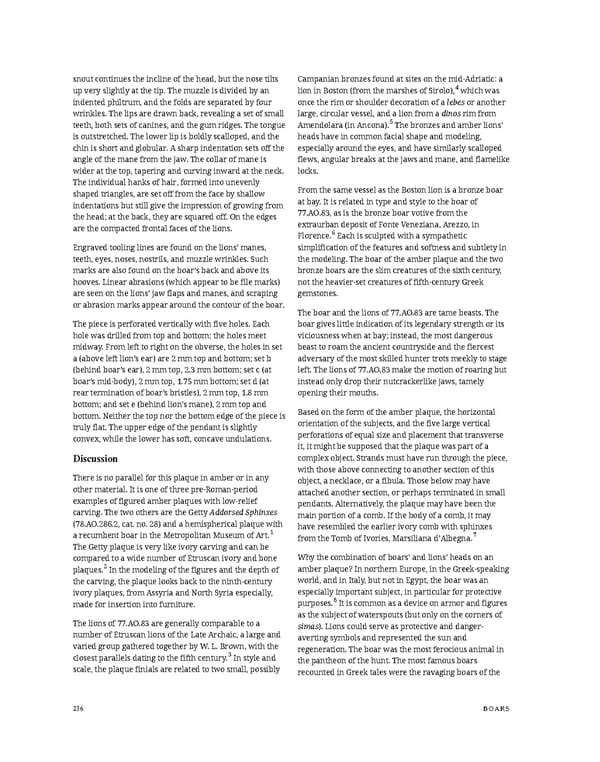snout continues the incline of the head, but the nose tilts Campanian bronzes found at sites on the mid-Adriatic: a up very slightly at the tip. The muzzle is divided by an lion in Boston (from the marshes of Sirolo),4 which was indented philtrum, and the folds are separated by four once the rim or shoulder decoration of a lebes or another wrinkles. The lips are drawn back, revealing a set of small large, circular vessel, and a lion from a dinos rim from teeth, both sets of canines, and the gum ridges. The tongue Amendolara (in Ancona).5 The bronzes and amber lions’ is outstretched. The lower lip is boldly scalloped, and the heads have in common facial shape and modeling, chin is short and globular. A sharp indentation sets off the especially around the eyes, and have similarly scalloped angle of the mane from the jaw. The collar of mane is flews, angular breaks at the jaws and mane, and flamelike wider at the top, tapering and curving inward at the neck. locks. The individual hanks of hair, formed into unevenly shaped triangles, are set off from the face by shallow From the same vessel as the Boston lion is a bronze boar indentations but still give the impression of growing from at bay. It is related in type and style to the boar of the head; at the back, they are squared off. On the edges 77.AO.83, as is the bronze boar votive from the are the compacted frontal faces of the lions. extraurban deposit of Fonte Veneziana, Arezzo, in Florence.6 Each is sculpted with a sympathetic Engraved tooling lines are found on the lions’ manes, simplification of the features and softness and subtlety in teeth, eyes, noses, nostrils, and muzzle wrinkles. Such the modeling. The boar of the amber plaque and the two marks are also found on the boar’s back and above its bronze boars are the slim creatures of the sixth century, hooves. Linear abrasions (which appear to be file marks) not the heavier-set creatures of fifth-century Greek are seen on the lions’ jaw flaps and manes, and scraping gemstones. or abrasion marks appear around the contour of the boar. The boar and the lions of 77.AO.83 are tame beasts. The The piece is perforated vertically with five holes. Each boar gives little indication of its legendary strength or its hole was drilled from top and bottom: the holes meet viciousness when at bay; instead, the most dangerous midway. From left to right on the obverse, the holes in set beast to roam the ancient countryside and the fiercest a (above left lion’s ear) are 2 mm top and bottom; set b adversary of the most skilled hunter trots meekly to stage (behind boar’s ear), 2 mm top, 2.3 mm bottom; set c (at left. The lions of 77.AO.83 make the motion of roaring but boar’s mid-body), 2 mm top, 1.75 mm bottom; set d (at instead only drop their nutcrackerlike jaws, tamely rear termination of boar’s bristles), 2 mm top, 1.8 mm opening their mouths. bottom; and set e (behind lion’s mane), 2 mm top and bottom. Neither the top nor the bottom edge of the piece is Based on the form of the amber plaque, the horizontal truly flat. The upper edge of the pendant is slightly orientation of the subjects, and the five large vertical convex, while the lower has soft, concave undulations. perforations of equal size and placement that transverse it, it might be supposed that the plaque was part of a Discussion complex object. Strands must have run through the piece, with those above connecting to another section of this There is no parallel for this plaque in amber or in any object, a necklace, or a fibula. Those below may have other material. It is one of three pre-Roman-period attached another section, or perhaps terminated in small examples of figured amber plaques with low-relief pendants. Alternatively, the plaque may have been the carving. The two others are the Getty Addorsed Sphinxes main portion of a comb. If the body of a comb, it may (78.AO.286.2, cat. no. 28) and a hemispherical plaque with have resembled the earlier ivory comb with sphinxes a recumbent boar in the Metropolitan Museum of Art.1 from the Tomb of Ivories, Marsiliana d’Albegna.7 The Getty plaque is very like ivory carving and can be compared to a wide number of Etruscan ivory and bone Why the combination of boars’ and lions’ heads on an plaques.2 In the modeling of the figures and the depth of amber plaque? In northern Europe, in the Greek-speaking the carving, the plaque looks back to the ninth-century world, and in Italy, but not in Egypt, the boar was an ivory plaques, from Assyria and North Syria especially, especially important subject, in particular for protective made for insertion into furniture. purposes.8 It is common as a device on armor and figures as the subject of waterspouts (but only on the corners of The lions of 77.AO.83 are generally comparable to a simas). Lions could serve as protective and danger- number of Etruscan lions of the Late Archaic, a large and averting symbols and represented the sun and varied group gathered together by W. L. Brown, with the regeneration. The boar was the most ferocious animal in closest parallels dating to the fifth century.3 In style and the pantheon of the hunt. The most famous boars scale, the plaque finials are related to two small, possibly recounted in Greek tales were the ravaging boars of the 236 BOARS
 Ancient Carved Ambers in the J. Paul Getty Museum Page 245 Page 247
Ancient Carved Ambers in the J. Paul Getty Museum Page 245 Page 247